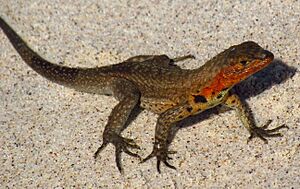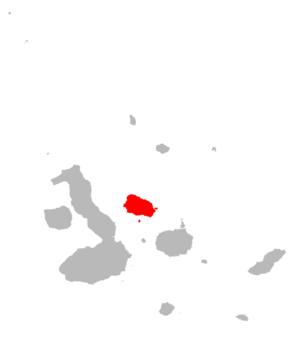Santiago lava lizard facts for kids
Quick facts for kids Santiago lava lizard |
|
|---|---|
 |
|
| Conservation status | |
| Scientific classification | |
 |
|
| Synonyms | |
|
The Santiago lava lizard (also known as Microlophus jacobii) is a special type of lava lizard. It belongs to the Tropiduridae family. These lizards live only on a few Galapagos Islands. You can find them on Santiago, Bartolomé, and Rábida. They also live on some smaller nearby islands.
These lizards are the only kind of lava lizard found on these specific islands. For a long time, people thought they were just a group of Galápagos lava lizards. But now, scientists agree they are their own unique species.
Contents
About Santiago Lava Lizards
Santiago lava lizards are active during the day. They live in rocky areas that have volcanic rock. You can also find them in dry areas with shrubs and grass. When the sun is hottest in the middle of the day, they find shade. This helps them stay cool.
At night, these lizards hide to sleep. They might go under the soil or find shelter among rocks. Sometimes, they hide in piles of dead leaves.
What Do They Eat?
These lizards eat both plants and insects. Their plant diet includes leaves, fruits, and seeds. They also enjoy eating different kinds of insects.
Who Are Their Predators?
Santiago lava lizards have natural enemies. One of them is the Thomas's racer, a type of snake. They also face threats from animals brought by humans. Black rats are an example of an invasive threat.
To escape from danger, these lizards are very quick. They often run and hide in small cracks in rocks. They have also been seen climbing into old nests of Santiago Island giant tortoises to stay safe.
How Santiago Lava Lizards Are Classified
Santiago lava lizards are part of a group called Iguania. This group includes many types of lizards. They belong to the Tropiduridae family. This family is made up of lizards mostly found in South America.
The scientific name for the Santiago lava lizard is Microlophus jacobii. The first part, Microlophus, means "small crest." This refers to a small ridge on the lizard's head. The second part, jacobi, comes from the old Latin name for Santiago Island, which was Jacobi (or James).
Male and Female Differences
Male and female Santiago lava lizards look different. This is called sexual dimorphism. Females are usually about 19 centimeters (about 7.5 inches) long. Males are bigger, growing to about 27 centimeters (about 10.6 inches).
Females typically have a brown body. They often have black marks near their shoulders. Their faces can be a bright orange or red color. Males have more varied colors than females. They usually have black and white spots on their brown bodies.
There are also many differences in colors and skin patterns among lizards of the same species. Male lizards have a raised crest along the middle of their back. This crest helps tell them apart from females.
Reproduction and Life Cycle
Santiago lava lizards reproduce by laying eggs. This means they are oviparous. Females usually lay 1 to 3 eggs at a time. They dig nests in sandy areas near rocks or plants.
After laying the eggs, the female protects the nest. She keeps predators away. She also stops other female lizards from disturbing her eggs. For courtship, male lizards perform special "push-up" displays. They also fight with other males to claim their territory.
Where They Live
These lizards are endemic to the central Galapagos archipelago. This means they live only in this specific area. Their home islands include Santiago, Rábida, Bartolomé, and six small islets nearby.
In total, the Santiago lava lizard species lives in an area of about 463 square kilometers (about 179 square miles).
Protecting Santiago Lava Lizards
The IUCN Red List lists the Santiago lava lizard as "least concern." This means they are not currently in great danger.
Most of their home, Santiago Island, does not have people living there permanently. Also, their entire habitat is inside Galapagos National Park in Ecuador. This park helps protect them. The main threat they face is from black rats. These rats were brought to the islands by humans and sometimes eat the lizards.


